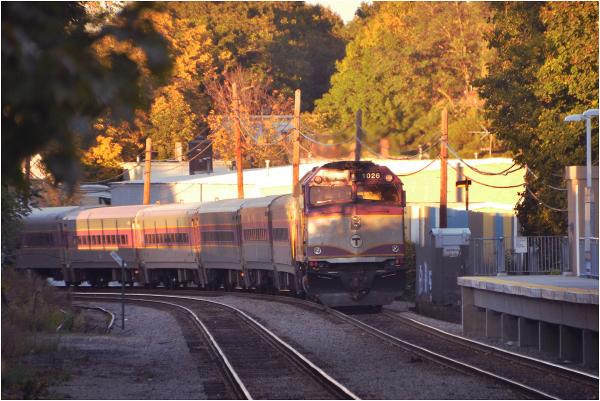October 14, 2020

Electrifying the Fairmount Line will "save commuters valuable time and improve air quality," argues a new report by advocacy group Transit Matters. Chris Lovett photo
Transportation advocates last week pointed to a newly released report on regional rail improvements as a roadmap to transforming the Fairmount Line into an electrified rail line with far-more-frequent and accessible service to the city neighborhoods it runs through.
The 18-page document— titled “Plan for Regional Rail Phase 1” and prepared by the advocacy group Transit Matters— includes cost estimates and timelines for the several regional rail lines— not just the Fairmount. But a significant section of the report zeroes in on the 8-mile section of rail that carves through Hyde Park, Mattapan, and Dorchester on its route between Readville and South Station.
It is the latest push in a decades-long campaign from advocates who say the commuter rail should be converted into a subway line, with frequency similar to the Red and Orange lines. The MBTA this year launched a pilot plan to improve service on the Fairmount Line – eight additional weekday trips, bringing service up to 24 trips per weekday. But advocates say a far more dramatic and costly shift is needed— a sentiment amplified in this new report.
Electrifying the rail corridor and buying new electric vehicles to replace the current fleet of diesel-powered locomotives would save commuters valuable time and improve air quality, the report argues. Changing the power source is the key plank of the Fairmount section of the report, along with buying new “rolling stock” cars or Electric Multiple Unit (EMUs) and adding high level platforms at all stations. The report lays out more than $2.6 billion in investments regionally over the next decade, including hundreds of millions for the Fairmount Line specifically.
“A lot of the stuff that we’re pushing for on the Fairmount line are things that advocates on that corridor have been pushing for a long time,” said Jarred Johnson, executive director of TransitMatters, during a virtual meeting to discuss the report last Thursday. “We’re really excited to be here and be echoing the work that has already been happening.”
In addition to electrifying the rail line in three segments over the next six years, the report calls for the installation of high-level platforms at Fairmount and Readville stations by 2026. It also envisions major infrastructure fixes to relieve bottlenecks, free transfers, and lower fares overall.
Johnson said that the overhaul would also aid the region’s economic recovery from the pandemic. “We had a transportation crisis before Covid-19, but now the pandemic has exacerbated a lot of existing inequities and brought in new ones,” he said, citing a decrease in commuter rail ridership system wide.
“Service has decreased to 7 percent at peak a.m. rush hour, and the all-day average is around 11 percent. The bus service is trying to cope with both the rising number of people coming back but also trying to keep distancing in effect and keep crowding low,” he said.
“The only sort of silver lining from these terrible numbers is that it emphasizes the point that we’ve thought for a long time— which is that the commuter rail, as a model, is not very sustainable and is somewhat obsolete,” he added. “It’s a very expensive system that is designed for a relatively small band of workers and then even within that, really limiting as far as the hours they’re able to travel.”
Ethan Finlan, a planner who works for TransitMatters, said the Fairmount Line, “along with the line from Brockton to Middleborough, has maintained most of its riders throughout the pandemic. Whereas the lines that entirely rely on suburban commuters have not done well, the Fairmount, contrary to what we’ve heard for years from skeptics – that it would never maintain ridership – in fact it has really been an asset throughout this time,” he said.
Finlan argued that adding overhead electrification along the line would speed up the modernization plans and was “essential” to meeting the state’s goal of zero emissions by 2050.
“Not only by making the rail lines more environmentally sound but also by improving reliability and speed, it can lead to a shift away from single occupancy vehicles that cause pollution along I-93 that permeates into Dorchester,” Finlan said.
Fare equity is also discussed at length in the report.
“The whole line should really be in the same fare zone as the subway, and Readville is about equidistance to Braintree which is in Zone 1A,” said Finlan. “There’s no reason why riders should have to pay up to $5 more to get anywhere on the corridor.”
Johnson said the group hopes to get a firm commitment from the Baker administration, the MBTA, and state legislators to move improvements forward.
“We’ve gotten the board to commit to modernization, but we haven’t necessarily gotten the Secretary [of Transportation Stephanie Pollack] or the State House,” he said. “We really need to have a firm commitment there in terms of a bond bill being passed and a clear plan laid out for how we’re going to get there.”
He added: “The next thing we’ve got to do is almost immediately start the process of buying these new trains because unfortunately these procurements take three to four years, and we need to start that process now.”
State Rep. Liz Miranda said that a lot of the concerns she’s heard from constituents are reflected in the report’s findings.
“We’ve all been committed to pushing the T, and if this is another thing we could get an early win on, I’m committing to help fight for that,” she said.
Sue Sullivan, executive director of the Newmarket Business Association, backed the report’s finding that many essential employees are using the Fairmount Line— and have been doing so throughout the pandemic.
“Newmarket never closed through the pandemic and most of our businesses have been working straight through,” she said. “And so we’ve had a lot of our workers continuing to ride it, and 52 percent of our employees come from within a few miles of where they work. A lot of them are along the Fairmount Line.”
As the meeting wrapped up, Johnson said working toward the goals outlined in the report would be “an all-hands-on-deck thing”— arming neighborhood activists with information to “push back on some of the arguments like: ‘Oh, the ridership is too low.’”
He doesn’t buy that, he said. “It’s having those things so when people are talking to the media or elected officials they can really say ‘Isn’t the fact that the Fairmount corridor has some of the worst air quality in the city enough to justify the fact that we should electrify?’ The report is here to underscore a lot of the points that folks sometimes use to throw at why we shouldn’t transform the Fairmount Line.”



